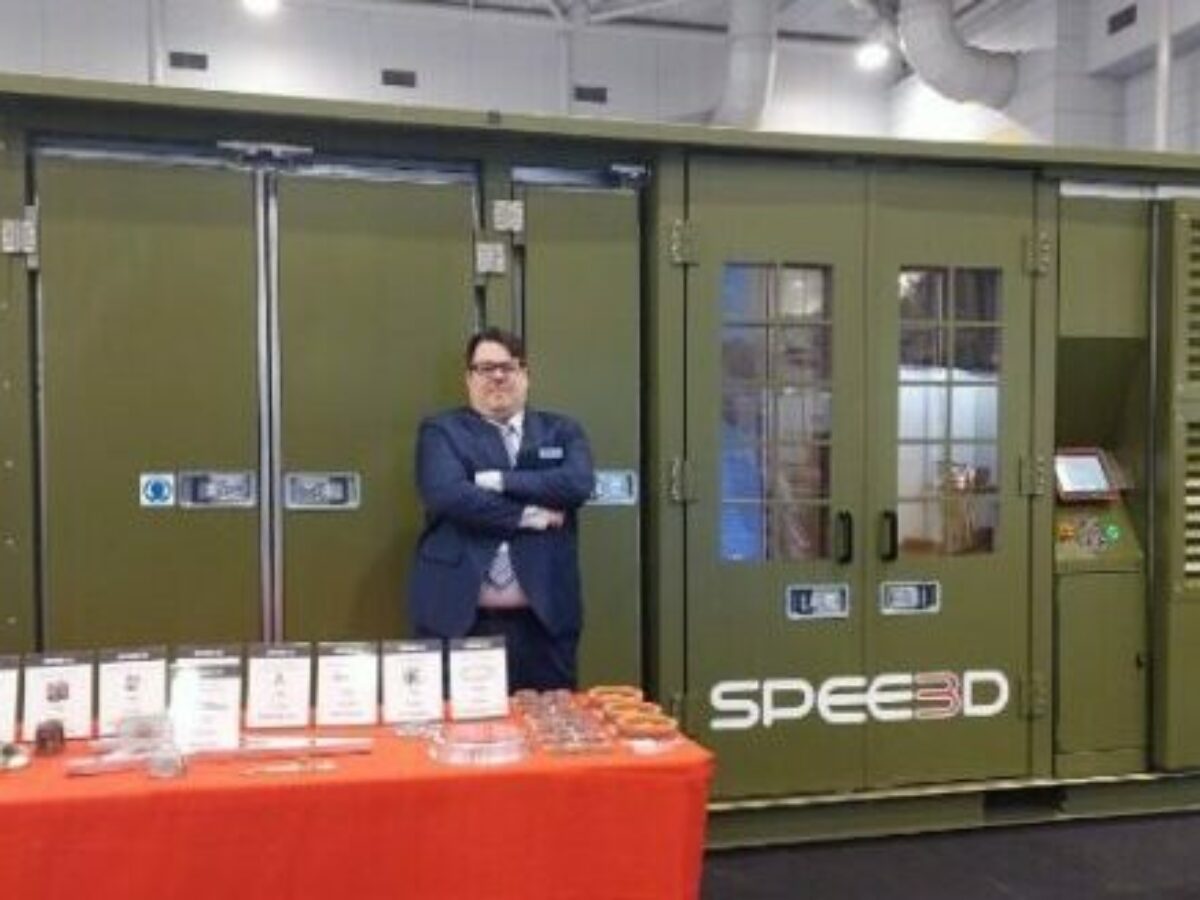Land Forces 2022 – The curse and the benefit of being Australian

Next in @AuManufacturing’s special editorial series, Land Forces 2022, we include an interview with SPEE3D’s Steve Camilleri, recorded during last week’s Land Forces expo in Brisbane.
SPEE3D did not set out to work with defence, a market that now makes up about half of the Australian technology company’s business, according to co-founder and CTO Steve Camilleri.
The company chose Land Forces last week for the launch of its containerised, ruggedised XSPEE3D additive manufacturing machine, developed through trials with the Australian Army, and designed “to resolve critical spare part requirements in the field.”
The trials earned SPEE3D the SME Innovation Award at last year’s event. It saw further recognition, and in US defence circles, with a Expeditionary & Tactical 3D Printing Excellence Award at the 6th Military Additive Manufacturing Summit in Tampa, Florida, earlier this year.
Progress with armed forces customers has been rapid but largely unexpected, and to begin with, Camilleri – as with many SME business leaders – wrote off the defence market as excessively complicated. He credits good timing and advocates within the Australian Army who recognised the company’s potential.
“We were very lucky, in a way, that the pandemic hit,” he told @AuManufacturing.
“Everyone was suddenly starting to have trouble with supply chains, Defence included. [And] their supply chains are built to be much more rugged and rigorous than, for example, your local football club’s supply chain.”
The company’s founders didn’t even begin with additive manufacturing. Like those of Tritium, they developed new technology as part of a university solar racing team, in the form of a very efficient electric motor.
Camilleri and Byron Kennedy (SPEE3D’s co-founder and CEO) founded their first company, In Motion Technologies, in 2002, before selling to Regal Beloit. The pair stayed on with Regal, helping it set up factories.
Camilleri estimates about 80 per cent of the world’s pool pumps nowadays operate off technology he and Kennedy developed at their former venture.
They formed their current company in 2015 after being frustrated by the slowness and cost of laser-based metal additive manufacturing, identifying cold spray as a possible solution to the “technology-shaped hole” they saw.
Instead of melting powders layer by layer, they would blast them out of a nozzle at several times the speed of sound to fuse them together on a substrate, instead of going from solid to liquid then back.
“That kind of was our ‘ah hah’ moment – working out that not melting the material was the solution to the speed limit,” recalls Camilleri, adding that their solution required solving a lot of thorny technical challenges.
Today they believe their process, which they say is up to 1,000 times quicker than traditional metal additive manufacturing, offers great potential to keep operations in isolated locations, for example ports or army bases or farms, up and running if a basic though important part breaks.
“You’re not the kind of person that yearns for a 3D printer, it’s not something that’s missing in your day, but what you do have is a lot of infrastructure, a lot of capital, and when that goes down very suddenly and unpredictably… you may not have any good choices on the table,” explains Camilleri.
On a ship might be another scenario, and the company’s printers were recently used aboard a US Navy ship during the Repair Technology Exercise (REPTX), reportedly printing five bronze anchors at sea, each in approximately six minutes.
Camilleri discusses the REPTX experience in this episode of @AuManufacturing Conversations with Brent Balinski, as well as the new expeditionary printer, SPEE3D’s accidental presence in the defence market, and much else.
He also shares how the company has borrowed a few ideas from celebrated Australian machine tool company ANCA in dealing with “the curse and the benefit” of Australia’s isolation.
“ANCA was one of the closest in terms of where we’d like to be eventually, so I think it made a lot of sense,” says Camilleri.
“They’re a Melbourne company, we do our manufacturing in Melbourne, we know a lot of the same kind of people, and we’re able to benefit from some of the lessons that ANCA had already learned by talking to those people…”
Episode guide
0:30 — The company’s history.
3:42 – “We knew exactly what we needed. We had a technology-shaped hole, we had to be able to print parts very quickly, so we targeted 100 grams a minute as our metric. We also decided that the parts needed to be able to be manufactured cheaply. So we were targeting about 100 bucks a kilo for our production cost. The first bit we worked out was that all the processes people were using already – mainly using lasers and electron beams and things like that – could not possibly achieve it.”
6:01 – Regarding cold spray: “There were papers at the time declaring loudly ‘this is a wonderful process, it would be perfect for additive manufacturing, but you can’t make geometries with it. It’s too constraining. You can only coat parts with it.’”
7:10 – Being daunted at first by the defence market and its complexity.
8:10 – “A bit of a coincidence” being discovered by the Australian Army for trials to see if they could solve a need.
10:10 – The new XSPEE3D printer plus the Hierarchy of Needs for 3D printer users.
12:42 – An insurance policy for isolated operations e.g. ports, farms: “You’re not the kind of person that yearns for a 3D printer, it’s not something that’s missing in your day, but what you do have is a lot of infrastructure, a lot of capital, and when that goes down very suddenly and unpredictably… you may not have any good choices on the table.”
15:05 – Pricing model.
16:10 – The current situation in Australia with metal powders and sovereign capability, and why this needs improving.
17:06 – Why the development partner for the printer is the UK’s Manufacturing Technology Centre (MTC) and not an Australian organisation.
18:50 – Demonstrating the usefulness of their tech to the US Navy at REPTX. (A research paper is currently being prepared on what was learned about printing at sea.)
23:25 – Why they’re borrowing ANCA’s approach in exporting Australian innovation. “Let’s go to the world, and let’s make sure we succeed, because we know that our domestic market isn’t enough to sustain us… The curse and the benefit of being Australia is this isolation. So we thought ANCA managed that extremely well.”
28:20 – How defence has supplied itself throughout history, why the global supply chain could be a little bit of a short-term aberration, and why the hose fitting makers of the world are doomed.
32:40 – Some closing thoughts on Australian industry development.
Picture: supplied
Further reading:
ARMY, SPEE3D RELATIONSHIP TO EXTEND WITH A NEW 12-MONTH TRIAL
SPEE3D SUCCESSFULLY PRINTS PARTS AT SEA FOR US NAVY – REPORT
LAND FORCES 2022 – 3D PRINTING TO REVOLUTIONISE LOGISTICS AT THE FRONT
LAND FORCES 2022 — COLD SPRAY AM CONTINUES TO PROGRESS ALONGSIDE DEFENCE
@AuManufacturing’s special editorial series Land Forces 2022 is brought to you with the support of Thales Australia and BAE Systems Australia.

![]()
Picture: SPEE3D
@aumanufacturing Sections
Analysis and Commentary Awards Defence Manufacturing News Podcast Technology Videos










